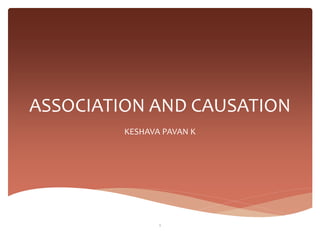
Association and causation
- 1. ASSOCIATION AND CAUSATION KESHAVA PAVAN K 1
- 2. INTRODUCTION Association is the concurrence of two variables more often than would be expected by chance. Events are said to be associated when they occur more frequently together than one would expect by chance 2
- 3. TYPES Spurious Indirect Direct One-to-one multifactorial 3
- 4. SPURIOUS ASSOCIATION Appears due to improper comparison Observed association between a disease & suspected factor may not be real. 4
- 5. INDIRECT ASSOCIATION Statistical association between a character of interest and a disease due to presence of another factor, known or unknown, that is common to both the factors. Altitude Iodine deficiency Endemic goitre 5
- 6. DIRECT ASSOCIATION Between two attributes that are directly related to each other. One-to-one causation: when disease is present, factor must also be present. e.g., Hemolytic streptococci causing tonsillitis, scarlet fever, erysipelas Multifactorial causation: alternative causative factors acting independently. e.g., lung cancer being caused by smoking, air pollutants. 6
- 7. CRITERIA FOR JUDGING CAUSALITY Bradford Hill report, 1964 Temporal association Strength of association Specificity of association Consistency of association Biological plausability Coherence of association 7
- 8. TEMPORAL ASSOCIATION Causal attribute must precede the disease or unfavourable outcome Exposure to factor must have occurred before the disease developed 8
- 9. STRENGTH OF ASSOCIATION If the association is strong or weak With increased level of exposure to risk factor, incidence of disease increases. 9
- 10. SPECIFICITY OF ASSOCIATION One to one relation between cause and effect Weakest of the criteria 10
- 11. CONSISTENCY OF ASSOCIATION Occurrence of association at some other time & place repeatedly. If a relationship is causal, findings should be consistent with other data. 11
- 12. BIOLOGICAL PLAUSABILITY Association must be consistent with other knowledge like mechanism of action, evidence from animal experiments etc. 12
- 13. COHERENCE OF ASSOCIATION Causal significance of an association is its unity with known facts that are thought to be related. 13
- 14. THANK YOU THANK YOU for reading my presentation. If you have any doubts or interesting cases in any subject of medicine, I will be delighted if you share at keshavapavan533@gmail.com 14
